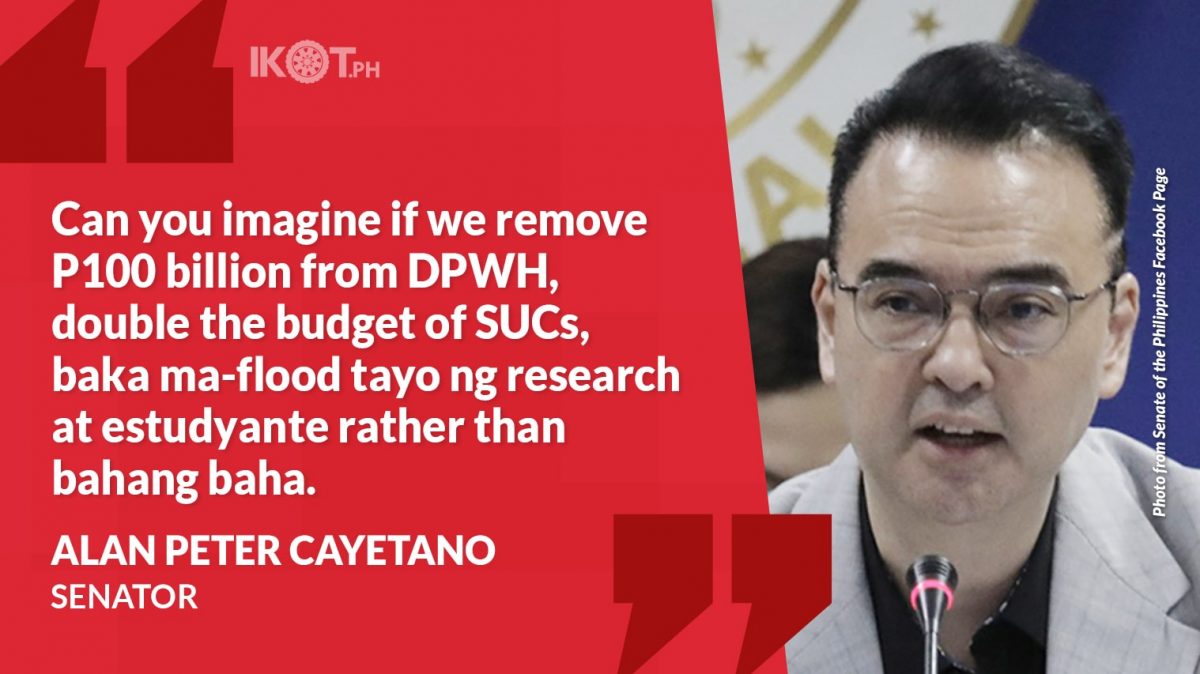Since flooding remains a persistent issue despite the over P300 billion spent year-on-year on anti-flooding structures, why not redirect part of that budget toward higher education?
Senator Alan Peter Cayetano floated this idea during the Senate debates on the 2025 budget for the Commission on Higher Education (CHED), where concerns over the reduced subsidy per student were discussed.
Cayetano emphasized that with a P6 trillion proposed national budget and P1 trillion allocated to DPWH, only P117 billion — or just 10 percent of DPWH’s budget — is earmarked for state universities and colleges (SUCs).
“For the last two years, more or less one trillion ‘yung [budget ng] DPWH, P350 billion doon ay anti-flood, [pero] ganoon pa rin ang flood natin,” the veteran legislator noted.
“Education would be a better or at least as good an investment as infrastructure, particularly a well-crafted scholarship system for college students.”
The seasoned lawmaker said education would be a “better” or at least as good an investment as infrastructure, particularly a well-crafted scholarship system for college students.
“Can you imagine if we remove P100 billion from DPWH, double the budget of SUCs (state universities and colleges), baka ma-flood tayo ng research at estudyante rather than bahang baha,” the senator said.
Reforming and funding the scholarship system
Cayetano said there is no doubt that investing in Filipinos through education requires increased funding, but he emphasized that CHED must ensure those funds are used effectively.
He urged CHED to reevaluate the United Financial Assistance System for Tertiary Education (UniFAST) — the current scholarship system for tertiary education — and find ways to make it more effective.
“If CHED comes out with a study regarding the best scholarship program and how good an investment it is to get people to go to the best universities, I think no one can debate with that.”
“If I tell you bawasan ng P50 billion ang DPWH, ilagay sa CHED o UniFAST, debate. But if CHED comes out with a study regarding the best scholarship program and how good an investment it is to get people to go to the best universities, I think no one can debate with that,” Cayetano explained.
He is concerned that the current model of free tuition at all state universities might not be the most effective approach for the country as it unintentionally distorts enrollment patterns, overpopulating public colleges while reducing competition.
“I’m not criticizing it per se. It’s better to have that system na napakaraming scholar. I’m just saying baka there’s a better system that will allow our SUCs to compete with the private sector and also allow them to be more entrepreneurial,” Cayetano explained.
He added that interventions that “interfere too much with market forces” is “not sustainable”.
“If you force [the] university to accept everyone, and then [put a] cap kung magkano tuition, nagkakagulo-gulo talaga ‘yung actual cost nila,” Cayetano said.
As an alternative, he urged CHED to find a strategic balance of resources between free tuition, student loans, and grants-in-aid.
“Since we hardly have any student loans, and since the scholarships now are in State Universities, I wonder how many ang parents na pinipilit kang mag-state U instead na private kasi nga sa state U, libre,” Cayetano said.
He underscored the need for a data-driven approach to scholarship reforms, noting CHED’s critical role in crafting a sustainable and effective system.
“Paano tayo magkakaroon ng no-balance billing sa college education pero hindi maapektuhan ang market forces or ‘yung economics of running a university?” he said.
“If we have the study this year, baka before the 10th year [of UniFAST] we can make the recommendations,” Cayetano concluded.


